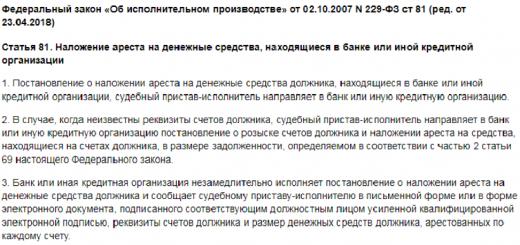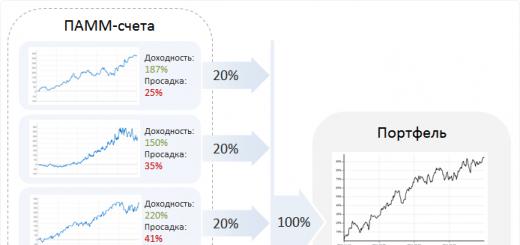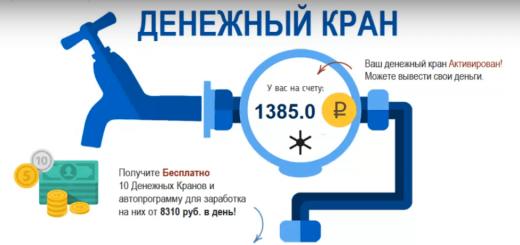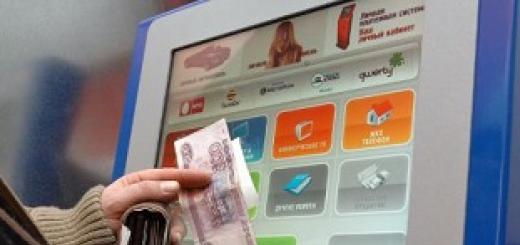Accounting for transactions with securities is necessary both in organizations that issue them and in enterprises that purchase shares as equity participation. In the article we will look at typical entries in securities accounting account 58 (sale, revaluation, loan) using examples.
A security is a document that certifies the property rights of the holder. Such rights can be exercised and transferred only upon presentation of paper. In the main types valuable papers include:
- stock;
- bills;
- bonds;
- checks;
- privatization papers:
- certificates of deposit.
A security is a document that, on the one hand, is used for financial investments, and on the other hand, to attract loans.
Subaccounts 58 accounts
Typically, accounting is kept in the following subaccounts of account 58
Accounting for securities on account 58
Let's look at the basic entries for accounting for transactions with securities using examples.
Purchase of shares
Mint LLC acquired a stake of 15 shares from Flagman LLC. at a price of 7200 rub. per share. The acquisition was made through an intermediary, JSC Kommersant, whose services amounted to 3,650 rubles.
In the accounting of Mint LLC, entries were made to account 58:
Revaluation of securities
The records of Mint LLC include shares of Flagman LLC (15 pieces, book value 7,200 rubles/piece). The accounting policy of Mint LLC provides for a quarterly revaluation of shares in accordance with their market value. The market price of the share as of the end of the reporting quarter was RUB 8,115/piece.
In the accounting of Mint LLC, the additional valuation of the share was reflected by the following entry:
Sale of securities
JSC Marathon acquired shares of LLC Magnat, the total cost of which was 137,000 rubles. As of December 31, 2015, stock quotes were RUB 124,000. In April 2016, Marathon JSC sold shares of Ballet LLC at a price of 148,000 rubles.
In the accounting of JSC Marathon, these transactions were reflected as follows:
| Dt | CT | Description | Sum | Document |
| 76 | Reflection of the share price under the agreement with Magnat LLC | 137,000 rub. | Sales and purchase agreement with Magnat LLC | |
| 76 | Transfer of the value of shares in favor of Magnat LLC | 137,000 rub. | Payment order | |
| 91 | Formation of a reserve (the difference between the market and book value of shares) RUB 137,000. — 124,000 rub. | 13,000 rub. | ||
| 91 | Reflection of the book value of shares sold by Ballet LLC | 137,000 rub. | ||
| 62 | 91 | Reflection of the value of shares sold in accordance with the agreement | 148,000 rub. | Sales and purchase agreement with LLC "Ballet" |
| 91 | Reflection of an increase in the value of shares due to a previously formed reserve | 13,000 rub. | Stock Market Quote Report | |
| 62 | Transfer of funds from Ballet LLC for sold shares | 148,000 rub. | Bank statement | |
| 91 | 99 | Reflection of profit from the sale of shares (RUB 148,000 + RUB 13,000 - RUB 137,000) | 24,000 rub. | Sales and purchase agreement with LLC "Ballet" |
Example of entries on account 09 for borrowing securities
Let us consider securities borrowing operations using the example of purchasing bonds registered with their owner.
Let’s imagine that Kremniy LLC purchased bonds from Sapphire JSC with a total nominal value of 351,000 rubles. In addition, Kremniy LLC incurred additional expenses for the purchase of bonds in the amount of RUB 84,000. The bonds provide for an income payment of 1.5% monthly. The maturity of the bonds is 9 months, i.e. after this time, Sapphire JSC is obliged to buy back the securities, thus repaying the loan.
The following entries were made in the accounting of Kremniy LLC:
| Dt | CT | Description | Sum | Document |
| 76 | Reflection of costs for purchasing bonds from JSC Sapphire | RUB 351,000 | ||
| 76 | 91 | Accrual of income (the difference between the nominal value of bonds and the costs of their acquisition) (351,000 rubles - 84,000 rubles) / 9 months. | 667 rub. | Bond placement agreement |
| 76 | 91 | Accrual of interest income (RUB 351,000 * 1.5%) | RUR 5,265 | Bond placement agreement |
| 76 | Transfer of funds from Sapphire JSC towards interest repayment | RUR 5,265 | Bank statement | |
| 91 | Reflection of the value of bonds on the balance sheet | RUB 351,000 | Bond placement agreement | |
| 76 | 91 | Sale of bonds of JSC Sapphire (loan repayment) | RUB 351,000 | Bond placement agreement |
Account 58 “Financial Investments” is intended to summarize information on the presence and movement of an organization’s investments in government securities, shares, bonds and other securities of other organizations, authorized (share) capital of other organizations, as well as loans granted to other organizations.
Sub-accounts can be opened for account 58:
1. 58-1 “Units and shares”
2. 58-2 “Debt securities”
3. 58-3 “Loans provided”
4. 58-4 “Deposits under a simple partnership agreement”, etc.
Subaccount 58-1 takes into account the presence and movement of investments in shares joint stock companies, authorized (share) capitals of other organizations, etc.
Subaccount 58-2 takes into account the presence and movement of investments in government and private securities (bonds, etc.).
Subaccount 58-3 takes into account the movement of monetary and other loans provided by the organization to individuals and legal entities (except for employees of the organization). Providing by the organization to individuals and legal entities(except for employees of the organization) loans secured by bills of exchange are accounted for separately in this subaccount.
In subaccount 58-4, the partner organization takes into account the presence and movement of contributions to common property under a simple partnership agreement.
Analytical accounting for account 58 is carried out by type of financial investments and the objects in which these investments were made. The construction of analytical accounting should provide the ability to obtain data on short-term and long-term assets. At the same time, accounting for financial investments within a group of interrelated organizations, about the activities of which a free report is compiled financial statements, is maintained on account 58 “Financial investments” separately.
Account 58 “Financial investments” corresponds with the accounts:
By debit
51 Current accounts
52 Currency accounts
75 Settlements with founders
80 Authorized capital
91 Other income and expenses
98 Deferred income
By loan
51 Current accounts
52 Currency accounts
76 Settlements with various debtors and creditors
80 Authorized capital
90 Sales
91 Other income and expenses
99 Profit and loss
Basic accounting entries count 58
1. d.58-2 k.50 Reflects the initial cost of financial investments in securities paid from the cash desk in cash
2. d.58-3 k.50 Cash loans provided to other organizations
3. d.58-2 k.51 Reflects the initial cost of financial investments in securities paid from the current account
4. d.58-3 k.51 Loans provided from the current account to other organizations
5. d.58-4 k.51 Reflects the cost of the contribution under the PT agreement made in cash by the partner organization
6. d.58-2 k.52 Reflects the initial cost of financial investments in securities paid from a foreign currency account
7. d.58-3 k.52 Loans provided from a foreign currency account to other organizations
8. d.58-2 k.75 Receipt of securities as payment for shares is reflected
9. d.58-1 k.76 Reflects the posting of deposits made to the organization’s capital
10. d.58-1 k.76 Obtained ownership rights to purchase shares
11. d.58-4 k.80 Reflects the receipt of financial investments made by the organization - a friend of the treasure account under the PT agreement
12. d.58-1 k.91-1 Reflects the excess of the monetary value of the contribution to the organization’s capital over the book value of the transferred property
13. d.58-2 k.91 The book value of bonds has been increased by the amount of positive exchange rate difference
14. d.58-1 k.98 Reflected in the form of gratuitously received property, the nominal value of additionally received shares
15. d.51 k.58-3 Reflects the return to the current account of loans previously provided to other organizations
16. d.52 k.58-3 Reflects the return to the foreign currency account of loans previously provided to other organizations
17. d.76 k.58-2 Part of the difference between the purchase and par value of debt securities was written off
18. d.80 k.58-4 Reflects the return of the contribution made in the form of financial investments to the partner organization withdrawing from the PT agreement
19. d.90 k.58-2 The book value of securities was written off upon their sale
20. d.91 k.58-2 The book value of redeemable bonds was written off
21. d.91 k.58-2 The book value of bonds was reduced by the amount of negative exchange rate differences
22. d.91 k.58-2 The book value of securities was written off upon their sale
23. d.91 k.58-4 Reflects the excess of the value of the deposit under the PT agreement over the value of the returned asset upon termination of the agreement
Financial investments"
58.1 - "Units and shares";
58.2 - “Debt securities”;
58.3 - “Loans provided”;
58.4 - “Deposits under a simple partnership agreement”, etc.
SHARE - a share of the capital of a company that gives the right to participate in general meetings shareholders to receive dividends and part of the company’s property upon its liquidation. P. is expressed in a specific document - a certificate, to which coupons for receiving dividends are attached.
SHARES are securities issued by a joint-stock company, the owners of which are granted all property and personal rights associated with the ownership of a share: a) the right to receive dividends, depending on the size of the corporation’s profit; b) the right to participate in the management of the corporation by voting at meetings; c) the right to receive part of the property after the liquidation of the corporation. Rights are exercised in an amount proportional to the size of the shares.
D 58 K 51 – the emergence of a financial investment object is reflected (when transferring or paying for this object from a current account);
D 58 K 76 – the occurrence of debt to counterparties is reflected (if payment for financial investment objects will be made after obtaining ownership rights to them, for example, in the case of securities).
D 91 K 58– reflects the negative difference between the purchase and par value (or between the par and purchase value) of the acquired debt securities.
In account 58, investments are accounted for at actual cost (in the amount of costs incurred for their acquisition).
Financial investments are the second most liquid after Money at the cash desk and on current accounts.
Account 59 “Reserves for the impairment of financial investments” is intended to summarize information on the availability and movement of reserves for the impairment of the organization’s financial investments.
The reserve is formed at the expense of financial results (as part of operating expenses), which is reflected in the accounting entry as a debit to account 91 “Other income and expenses” and a credit to account 59 “Provisions for impairment of financial investments.” A similar entry is made when increasing reserves in the event of a further decrease in the estimated value of financial investments.
The reserve is reduced (used) in the following cases: if the estimated value of the relevant assets in reporting period increased if their value is no longer subject to a sustained significant decline, as well as upon disposal of these assets. In this case, an entry is made in the debit of account 59 “Provisions for impairment of financial investments” in correspondence with the credit of account 91 “Other income and expenses”.
Financial investments for which an impairment reserve has been created are reflected in the financial statements at book value minus the reserve amount. In the net balance sheet, when reflected in the asset, the difference between 58 and 59 accounts is reflected. Those. There is no account in the liabilities side of balance 59!
Reserve for depreciation of financial investments” (passive, contractual to account 58).
If we have a large number of shares of one company, and its shares have sharply decreased in price, we cannot reflect these changes in account 58, because this will lead to misstatement of the financial statements.
The reserve for impairment of financial investments is created by the following entry:
D 91.2 K 59
D 59 K 91.2 – reserve amount restored
As soon as financial investments are disposed of, the corresponding reserve amounts are written off to other income of the enterprise (91.1).
Regulatory regulation of the accounting of bills of exchange is carried out by the “Regulations on promissory notes and bills of exchange” dated August 7, 1937.
When purchasing bills of exchange, they are accounted for at actual cost on account 58, disposal is reflected through account 91.
D 60 K 91– we pay the supplier with a bill of exchange.
If we purchased a bill with a face value of 1000 rubles, and with a discount it was transferred to us for actually 900 rubles, then we will reflect in the accounting the purchase price - 900 rubles.
Upon disposal of this bill, we will make the following entries:
D 60, 76 K 91.1 1000
D91.2 K 58 900
A credit balance of 100 rubles is formed, and income tax is paid on it.
If we provide a loan, we make the following entries:
D 58 K 51
If our main activity is the purchase and sale of financial investments, then income and expenses are charged to account 90, otherwise - to account 91.
When transferring shares, bills, i.e. When they are disposed of and sold, the following entry is made:
D 90.1, 91.2 K 58
Wiring cannot be done: D 60 K 58
D 76 K 91.1– interest accrued on loans is reflected;
If the loan is provided to an employee, then interest will be accrued to account 73.
D 73 K 91.1
If we have been accrued dividends on the objects of any financial investments, then we will reflect their receipt by posting:
D 51 K 91.1
58.4 - “Deposits under a simple partnership agreement”(joint activity of enterprises, which is carried out on the books of one of the enterprises);
When depositing assets, account 58 is used.
Under the simple partnership agreement, funds were deposited from the current account:
D 58 K 51
The following materials were included under the simple partnership agreement:
D 58 K 10
And if we bring them in at a higher price, then the transfer of materials will have to be reflected this way.
Accounting account 58 is the active “Financial Investments” account. On synthetic account 58, accounting of the organization's investments is organized. Using standard postings and practical examples, we will study the specifics of using account 58 and the features of reflecting transactions for accounting for financial investments.
Debit turnover on account 58 “Financial investments” occurs when an organization invests its free assets:
- IN authorized capitals or securities;
- Debt securities, bills, bonds;
- Provides a loan to a non-employee of an organization or legal entity, etc.
Credit turnover on account 58 “Financial investments” occurs in the following cases:
- Sales of securities or shares in the authorized capital;
- Leaving society;
- Free transfer;
- Transfer of securities in the form of a contribution to the authorized capital of other organizations;
- Redemption (redemption) of securities;
- Repay loans.
The diagram shows the sub-accounts opened to the account by type of financial investment:
Analytical accounting for account 58 “Financial investments” must ensure the disclosure of certain information, which is presented in the diagram:

Examples of accounting for financial investments in account 58 with postings
Example 1
Let's consider an example of paying for a share in the authorized capital by transferring a previously used fixed asset. If the market price is determined including VAT.
The table shows the source data of the example:
| Dt | CT | Sum,
rub. |
Wiring Description | Document |
| 58-1 | 76 | 569000 | Cost of financial investment including VAT | LLC establishment agreement, |
| 02 | 01 | 73810 | Accrued depreciation on equipment written off | Certificate of acceptance and transfer of OS |
| 76 | 01 | 597190 | The residual value of the equipment was written off (671,000-73,810) | Certificate of acceptance and transfer of OS |
| 19 | 68 | 107512 | The restored amount of VAT is indicated as a separate line in the Certificate of Acceptance and Transfer of Assets; When transferring property to the authorized capital of the Tax Code of the Russian Federation, it does not provide for the obligation for the transferring party to draw up an invoice for the amount of restored VAT |
|
| 76 | 19 | 107512 | The amount of restored VAT is included in calculations for the transfer of property, since the market price is determined taking into account VAT | Accounting certificate calculation |
| 91 | 76 | 135702 | Other expense is recognized as the difference between residual value OS + recovered VAT and the cost of OS, established by an independent appraiser (671000-73810+107512)-569000=135 702 |
Accounting certificate calculation |
Example 2
Let's consider an example of paying for a share in the authorized capital by transferring a previously used fixed asset. If the market price is determined without VAT.
Let’s assume that the organization, the sole founder of an LLC, paid for its share in the authorized capital of the LLC with used equipment. The market price of the equipment was carried out by an independent appraiser and approved by the LLC participants.
The table shows data for the example:
The following transactions were generated for account 58:
| Dt | CT | Sum,
rub. |
Wiring Description | Document |
| 58-1 | 76 | 482204 | The value of the financial investment was determined by an independent appraiser excluding VAT | LLC establishment agreement, The decision of the participants to evaluate the non-monetary contribution, Certificate of state registration of LLC |
| 02 | 01 | 73810 | Accrued depreciation written off | Certificate of acceptance and transfer of OS |
| 76 | 01 | 597190 | The residual value of the equipment is written off (671000-73810) | Certificate of acceptance and transfer of OS |
| 19 | 68 | 107512 | VAT has been restored in proportion to the residual value of the equipment ((671000-73810)*18%) | Accounting certificate calculation; The restored VAT amount is indicated as a separate line in the Certificate of Acceptance and Transfer of Assets When transferring property to the authorized capital, the Tax Code of the Russian Federation does not provide for the obligation for the transferring party to draw up an invoice for the amount of the restored VAT. |
| 58 | 19 | 107512 | Recovered VAT is charged to the increase in the initial cost of the financial investment, since the market value is determined without taking into account VAT | Accounting certificate calculation |
| 91 | 76 | 114986 | Other expenses are recognized in the form of the difference between the residual value of fixed assets and the cost of fixed assets established by an independent appraiser (671000-73810)-482204=114986 |
Accounting certificate calculation |
Example 3
Let's look at the postings to account 58 when selling shares.
Let’s assume that an organization has investments in registered uncertificated shares of Adrenaline Bank in the amount of 2,200,000 rubles on account 58-1. in the amount of 600,000 pieces with a denomination of 1 ruble. The organization sold these shares for the amount of RUB 3,100,000.
The organization's accounting should reflect the following entries in account 58 when selling shares.
Account 58 “Financial Investments” reflects information on the availability and movement of the organization’s investments in government securities, shares, bonds and other securities of other organizations, authorized capitals of other organizations, as well as loans granted to other organizations.
Sub-accounts can be opened for account 58 “Financial investments”:
58-01 "Shares"; 58-
02 "Promotions"; 58-
03 "Bonds"; 58-
04 "Bills"; 58-
05 "Loans provided"; 58-
06 "Deposits under a simple partnership agreement"; 58-
07 "Deposits"; 58-
09 "Other"; 58-
10 "Costs of financial investments."
Financial investments are accepted for accounting in the amount of actual costs for the investor. The actual costs of purchasing securities may be: -
amounts paid in accordance with the contract to the seller; -
amounts paid to specialized organizations and other persons for information and consulting services related to the acquisition of securities; -
remunerations paid to intermediary organizations with whose participation the securities were purchased; -
interest expenses on borrowed funds used to purchase securities before they are accepted for accounting; -
other expenses directly related to the acquisition of securities.
The amount of actual costs for the organization’s financial investments is reflected in the debit of subaccount 58-10 “Costs of making financial investments” in correspondence with the accounts that record the values to be transferred on account of these investments, and is written off from the credit of this subaccount to the debit of the corresponding subaccounts of account 58 "Financial investments".
Subaccounts 58-01 "Shares" and 58-02 "Shares" account for investments in shares of joint-stock companies, authorized capitals of other organizations created in the country and abroad.
The amount of funds in the amount according to constituent documents, transferred to the authorized (share) capital of the organization, is debited to subaccounts 58-01 "Shares", 58-02 "Shares" in correspondence with the credit of subaccount 50-01 "Cash of the organization", accounts 51 "Current accounts", 52 "Currency accounts."
By the debit of subaccounts 58-01 "Shares", and 58-02 "Shares" in correspondence with the credit of accounts: 01 "Fixed Assets", 04 "Intangible Assets", 10 "Materials", 41 "Goods", 43 "Finished Products" the transfer of the organization's property to the authorized capital is reflected. In this case, the difference between the assessment of the deposit reflected in subaccounts 58-01 “Shares” and 58-02 “Shares” and the value of the transferred property is reflected in the credit (as operating income) or debit (as operating expense) account 91 “Other income and expenses ".
By credit of subaccounts 58-01 "Shares" and 58-02 "Shares" in correspondence with accounts: 01 "Fixed assets", 04 "Intangible assets", 10 "Materials", 41 "Goods", 43 "Finished products", 50 “Cash Office”, 51 “Cash Accounts”, 52 “Currency Accounts” reflect transactions of return to the participant (founder) of his contribution to the authorized capital of the organization upon its liquidation or withdrawal of the contributing organization from the list of participants (founders) in the form of cash, fixed assets, intangible assets, inventories, goods etc.
When purchasing shares on the secondary securities market, the formation of the value of shares of other organizations is reflected in the debit of subaccount 58-02 “Shares” and the credit of account 76 “Settlements with various debtors and creditors”.
When selling shares of other organizations, their value, recorded in subaccount 58-02 "Shares", is written off as a debit to subaccount 91-02 "Other expenses".
Analytical accounting of investments in the authorized capital of other organizations is carried out for each organization.
Subaccount 58-03 “Bonds” takes into account the presence and movement of investments in government and private debt securities.
The purchase of bonds is reflected in the debit of subaccount 58-03 “Bonds” and the credit of account 51 “Current accounts”.
When purchasing bonds on the secondary securities market, their cost is W.W.W...I.n.e.t.L.i.b:Ru. -
includes part of the interest (income) accrued by the seller since his last payment.
When purchasing debt securities for which the current market value is not determined, at a price lower or higher than their nominal value, the difference between the amount of actual acquisition costs and the nominal value is allowed to be attributed evenly to financial results during the period of their circulation as the income due on them accrues. The procedure for bringing debt securities purchased at a price different from their face value during the circulation period must be provided for in accounting policy organizations.
When writing off the amount in excess of the purchase price of bonds acquired by an organization over their par value, entries are made in the debit of account 76 “Settlements with various debtors and creditors” and in the credit of subaccount 58-03 “Bonds” (for part of the difference between the purchase and par value, subject to equal write-off in during the circulation period of the bonds); the debit of account 76 “Settlements with various debtors and creditors” and the credit of account 91 “Other income and expenses” (for the difference between the amount of income receivable on the bonds and part of the difference between the purchase and face value of the bonds).
When additionally accruing the amount of excess of the par value of the bonds acquired by the organization over their purchase price, entries are made in the debit of account 76 “Settlements with various debtors and creditors” and in the credit of account 91 “Other income and expenses” (for the amount of income due on securities); the debit of subaccount 58-03 “Bonds” and the credit of account 91 “Other income and expenses” (for part of the difference between the purchase and nominal value, subject to uniform write-off during the circulation period of the bonds).
The receipt of income on securities to the current account is reflected in the debit of account 51 “Settlement accounts” and the credit of account 76 “Settlements with various debtors and creditors”.
Redemption (redemption) and sale of securities accounted for in subaccount 58-03 "Bonds" are reflected in the debit of subaccount 91-02 "Other expenses" and the credit of subaccount 58-03 "Bonds" (except for organizations that reflect these transactions in account 90 "Sales").
Subaccount 58-04 “Bills” reflects the availability and movement of financial bills.
Financial bills represent investments by an organization with the purpose of generating income. Financial bills are accepted for accounting in the amount of actual costs for the investor. Income from a financial bill is generated at the time of its sale or presentation for payment. The date of turnover under a financial bill is considered to be the day of its transfer to the new owner (endorsement date) or the date of its presentation (acceptance date).
When disposing of bills before maturity, repaying an interest-bearing financial bill, repaying a discount financial bill, transferring a third party bill of exchange as payment to a supplier or other creditor, the carrying amount of the financial bill is written off from the credit of subaccount 58-04 “Bills” to the debit of subaccount 91-02 “Other expenses” ".
A bill not paid on time is subject to protest. To make a protest, the holder of the bill presents the unpaid bill to the notary at the location of the payer. The notary draws up a protest act and makes a corresponding note on the bill. The registration of a protest on a financial bill for the amount of par value is reflected in the debit of account 76 “Settlements with various debtors and creditors”, subaccount 25 “Settlements on claims” and the credit of subaccount 58-04 “Bills”.
Bills of exchange can be pledged to secure a loan. Bills of exchange transferred to the bank to secure a loan or for collection continue to be listed in the accounting records of the organization-bill holder in subaccount 58-04 “Bills” with an indication in the analytical accounting of the bank to which they were pledged. In case of non-repayment of the loan, the bank retains the bill of exchange secured by the loan, and the carrying value of the retired bill of exchange is written off from the credit of subaccount 5804 “Bills of Exchange” to the debit of subaccount 91-02 “Other expenses”.
Subaccount 58-05 “Loans provided” takes into account the movement of funds provided by the organization to legal and individuals(except for employees of the organization) cash and other loans (including under a commercial loan agreement). Loans provided by the organization to legal entities and individuals (except for employees of the organization) secured by bills of exchange are accounted for separately in this subaccount.
Loans provided are reflected in the debit of subaccount 58-05 “Provided loans” in correspondence with account 51 “Current accounts” or other relevant accounts.
Under a commercial loan agreement, the organization provides a deferred payment of funds for goods sold, work performed, and services rendered. Sum accounts receivable organizations for goods sold, work performed, services rendered is reflected in the debit of account 62 “Settlements with buyers and customers” or account 76 “Settlements with various debtors and creditors”. The provision of a commercial loan is reflected in the debit of subaccount 58 5
“Loans provided” in correspondence with account 62 “Settlements with buyers and customers” or account 76 “Settlements with various debtors and creditors”.
Repayment of a loan (including that provided under a commercial loan agreement) is reflected in the debit of account 51 “Current accounts” or other relevant accounts and the credit of subaccount 58-05 “Provided loans”.
In subaccount 58-06 “Deposits under a simple partnership agreement,” the partner organization takes into account the presence and movement of contributions to common property under a simple partnership agreement.
The provision of a deposit is reflected in the debit of subaccount 58-06 “Deposits under a simple partnership agreement” in correspondence with account 51 “Current accounts” and other relevant accounts for accounting for allocated property. Upon termination of a simple partnership agreement, the return of property is reflected in the credit of subaccount 58-06 “Deposits under a simple partnership agreement” in correspondence with the property accounting accounts.
Subaccount 58-07 “Deposits” takes into account the movement of funds invested by the organization in bank and other deposits.
The transfer of funds to deposits is reflected by the organization in the debit of subaccount 58-07 “Deposits” in correspondence with account 51 “Currency accounts” or account 52 “Currency accounts”. Upon return credit institution the amounts of deposits in the organization's accounting records are reversed. The accrual of interest on deposits is reflected in the debit of subaccount 58-07 “Deposits” and the credit of account 91 “Other income and expenses”.
Analytical accounting for subaccount 58-07 “Deposits” is maintained for each deposit.
Subaccount 58-09 “Other” is intended to summarize information on the availability and movement of other types of financial investments.
Subaccount 58-10 “Costs of making financial investments” is intended to summarize information about the costs incurred by the organization in making financial investments. After completing the formation of the initial value of financial investments, they are accepted for accounting in the corresponding subaccounts of account 58 “Financial investments”.
Analytical accounting for account 58 “Financial investments” is carried out by types of financial investments and objects in which these investments are made (organizations that sell securities; other organizations in which the organization is a participant; borrowing organizations, etc.). The construction of analytical accounting should provide the ability to obtain data on short-term and long-term assets. At the same time, accounting for financial investments within a group of interrelated organizations, about the activities of which consolidated financial statements are prepared, is kept separately in account 58 “Financial investments”.
Table 5.6.
Account 58 "Financial investments" corresponds with the accounts On debit On credit 50 "Cash" 51 "Settlement accounts" 51 "Settlement accounts" 52 "Currency accounts" 52 "Currency accounts" 76 "Settlements with various debtors and creditors" 75 "Settlements with founders" 80 "Authorized capital" 7 6 "Settlements with various debtors and creditors" 90 "Sales" 80 "Authorized capital" 91 "Other income and expenses" 91 "Other income and expenses" 99 "Profits and losses" 98 "Future income periods"










